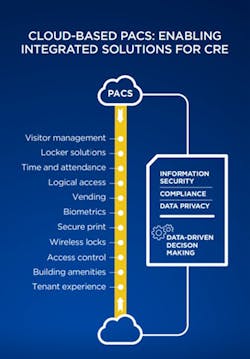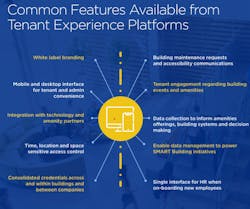This article originally appeared in the November 2022 issue of Security Business magazine. When sharing, don’t forget to mention Security Business magazine on LinkedIn and @SecBusinessMag on Twitter.
Security integrators serving clients in the Commercial Real Estate (CRE) industry are seeing a recurring theme: from the car park to the office suite, and across countries and regions, there is a common need to ensure a building’s people and assets are safe and secure while reducing friction at all access control touchpoints. Most importantly CRE providers need to offer meaningful amenities and experiences that employees and visitors value.
Building tenants are also driving new ways to work that require integrators to help their CRE clients accommodate additional needs. Tenant employees want flexible, multi-location, and hybrid work styles that include work-from-home and in-office hot-desking. They want contact-free access to doors and elevators, and intuitive features and amenities that make their journey to and from the office easier. And the ubiquitous mobile phone has become the command center for their lives; a single device that consolidates both work and life.
To address these needs, security professionals need to help those managing the building to deploy a modern physical access control system (PACS) that enables robust experiences, mobile adoption across systems, and future-ready, touchless access control.
What Tenants Want
From their home to the office suite, tenants interact daily with a vast array of disparate systems as they access a consistent set of services, having to manage multiple keys, cards, fobs, passwords, and other credentials, creating friction andfrustration.
“The challenge as a landlord is to provide the tenants and their guests the ability to come into an owner-controlled perimeter (e.g., turnstile), interact with a destination elevator system and then get into their office space in a seamless manner, with one credential,” says James Whalen, SVP and Chief Information and Technology Officer for Boston Properties. “They don’t want to have two cards. That’s the most basic definition of a seamless experience: through space, with least friction. You think about New York, some of these buildings have thousands of employees and get 18 to 19,000 visitors a month. Our goal is to move that queue in a quicker way through innovation.”
In addition to these requirements, the pandemic surfaced a new social awareness of health and safety, driving tenants to seek solutions that meet the requirements of today and tomorrow. With contactless checkpoints and advanced visitor management capabilities including unattended self-serve check-in, they want to enhance the workplace experience and its management by:
- Reducing surface touches
- Understanding who is accessing facilities
- Keeping common areas free of congestion
- Supporting appropriate social distancing
- Balancing a mix of work-from-home and in-office working styles
- Offering broad amenities and services for tenants
- Capturing data for better systems management and decision-making
How Integrators Can Help with Cloud-Based PACS
Today’s buildings range from a managed, multi-tenant property to a company-owned headquarters facility with many satellite operations worldwide. In any scenario, it can be difficult to scale access control deployments without largeinfrastructure investments.
Organizations can solve this problem by working with a security integrator who understands how to leverage cloud-based PACS technology as the flexible, easily scalable and future-proofed foundation of a modern building experience.
Hosted in the cloud (off-premise data center) and often procured on a subscription model, cloud-based PACS enable centralized management of cloud-connected access control devices, applications and trusted mobile identities. This in turn enables remote management of PACS systems in multi-tenant and multi-location environments with the high level of integration needed to deliver a seamless experience across systems.
This approach also facilitates a comprehensive tenant experience including access to the turnstile, the elevator, the seventh floor, the ninth floor, and the data center in the basement. It links all of these entitlements as part of one digital identity.
Cloud-Based PACS provides end-to-end information security, compliance, and data privacy, while also enabling data-driven decision-making. In support of a seamless experience, it enables integrations with a range of access use cases as well as centralized control over property technology solutions. Tight integration of these various technologies can help overcome key access control challenges and make it easier to manage through the lifecycle of an identity while offering key amenities and services.
Access control is very important, especially adopting mobile credentials. As an engagement model, mobile access defines active users and grounds them in daily interactions that help with all the other interactions, whether they are amenities and services, food and beverage, events, or building communications. It creates the fabric of the daily engagement model at home or in the office.
Mobile Access is a Key Enabler
One of the biggest areas where integrators can deliver value is in providing their clients’ building tenants with a mobile experience. Mobile devices are ubiquitous and inherently secure, a perfect form factor for access control. Because people are never without their phones, these devices can serve as a central component for improving the experience of interacting with and moving through buildings. They offer a higher level of convenience and greater security than is possible withplastic cards – so many of which today’s employees have lost or misplaced during such a long period of working from home.
From the administrator’s perspective, cloud-based PACS mobile enables over-the-air provisioning and remote administration while empowering credential management across multiple tenants and locations. It alleviates much of the administrative burden associated with management of physical credentials, which involves archaic workflows and face-to-face time involved with each of what can be hundreds or thousands of individuals. It also supports the short-term credentialing needed in a hybrid workforce model.
Mobile devices can readily integrate with a visitor management solution, simplifying the credentialing process for administrators and end-users. Credentials can be delivered by email and downloaded to the device without a face-to-face interaction with the front desk. Tenants no longer have to wait for shipping of cards or come into a building to physically collect a card. With mobile, thousands of credentials can be issued remotely to users’ phones through a few mouse clicks, enabling tenants to walk straight into the building on Monday morning.
For the end-user, the benefits of mobile include a single device for access control and other integrations, a more seamless experience, and touchless functionality in support of health and safety. Integrations beyond physical access control support things like tenant engagement, logical access systems, and mobile-friendly access to building amenities.
Meanwhile, mobile’s ease of management gives building owners and operators transparency in the system that did not previously exist. As an added bonus, these solutions are eco-friendly, taking plastic cards out of the access control ecosystem. This can be a boon to resident satisfaction, in addition to helping the environment.
Taking the Next Step with a Tenant Experience Platform
The modern tenant experience is inherently complex. Each property is used for an array of purposes with a distinct assortment of tenants, visitors, and contractors. Each user requires access to a unique set of services, and each access point has its own functionality. Tenants want a seamless experience for their employees, with a single device for access to all touchpoints, and a frictionless experience across disparate systems.
People also have grown fatigued from having so many passwords, and different apps on their phone when they only use a few. They want more convenience and to improve their day-to-day life. They want the right information at their fingertips and interoperability among the different systems they engage with. By leveraging PACS in support of the modern tenant experience, companies can integrate technologies across their workplaces into a single interface, creating an attractive and innovative environment.
One way security professionals can help their clients address these issues is with a tenant experience platform – a desktop or mobile application that brings together all the things that companies should look for when exploring properties to house their operations – all in a single solution. The application extensively acts as a remote control for how a tenant interfaces with the physical space around them, from wayfinding, local restaurants and available fitness classes to weather, and traffic updates, along with mobile access. Being able to have one seamless, organized interface versus needing to potentially download eight to 10 different applications to use in the building on a day-to-day basis is extremely valuable.
Serving as a “single source of truth,” tenant experience platforms integrate access control, visitor management, building operations (alerts, maintenance requests, broken elevator, etc.), shared asset management (booking shared rooms or spaces), as well as custom experiences like local dining options, yoga schedules, and café specials.
What the Future Looks Like
One example of what’s ahead can be seen in the February 2022 announcement from Silverstein Properties that it had added contactless access to its 7 World Trade Center office building through an employee badge in Apple Wallet.
To help create this experience, HID partnered with Silverstein and SwiftConnect, whose Access Cloud manages and connects disparate access control systems across owner and enterprise portfolios with mobile credential platforms, user directories, and other systems that influence physical access requirements. SwiftConnect Access Cloud and Silverstein’s Inspire app integrate with HID Origo, a cloud platform that enables lifecycle management of mobile credentials. This tenant experience platform also leverages HID’s Seos credential technology to deliver an intuitive, private, and secure access transaction when a user presents their iPhone or Apple Watch to HID Signo Readers.
With Silverstein’s solution, tenants can easily access the company’s office buildings and their tenant floors, fitness centers and amenity spaces using their iPhone or Apple Watch. First, they add their employee badge to Apple Wallet after an initial set-up through an app. They can then hold their device near the door’s NFC-enabled lock to access secured areas. To deliver this access experience in even the most extreme circumstances, employee badges stored in Apple Wallet works in Power Reserve mode when the iPhone needs a charge.
Solutions like these will also address the shift in what employees expect from their work environment. Those who return to the office have a new mindset forged during a lengthy period of working from home. Some will want the same digital conveniences of their home environment. Others will need the assurances of touchless access, social-distancing, and hygiene measures that can only be efficiently managed through a tenant experience platform that integrates with beacon-based location services technologies and other automated solutions to these challenges.
Still others will need to operate in both worlds, seamlessly moving between the two environments and expecting the same experience in each. Delivering these experiences in a world where someone’s identity is the new – and often only – perimeter will put pressure on those owning and leasing their buildings to implement multi-factor authentication and other measures associated with a Zero Trust security model. This, too, will rely on the solid foundation of a cloud-based, mobile-first tenant experience platform.








